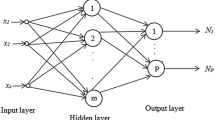Abstract
In this paper, we give a constructive proof that a real, piecewise continuous function can be almost uniformly approximated by single hidden-layer feedforward neural networks (SLFNNs). The construction procedure avoids the Gibbs phenomenon. Computer experiments show that the resulting approximant is much more accurate than SLFNNs trained by gradient descent.
Similar content being viewed by others
Explore related subjects
Discover the latest articles, news and stories from top researchers in related subjects.References
Burton RM, Dehling HG (1998) Universal approximation in p-mean by neural networks. Neural Netw 11: 661–667
Cai W, Gottlieb D, Shu CW (1989) Esentially nonoscillatory spectral Fourier methods for schock wave calculations. Math Comput 52: 389–410
Candes E, Donoho D (1999) Ridgelets: a key to higher dimensional intermittency?. Philos Trans R Soc Lond Ser A 357: 2495–2509
Candes E, Donoho D (1999) Curvelets: a surprisingly effective nonadaptive representation of objects with edges. Technical Report, Department of Statistics, Stanford University
Claypole P, Davis G, Sweldens W, Baraniuk R (2003) Nonlinear wavelet transforms for image coding via lifting. IEEE Trans Image Process 12: 1449–1459
Colzani L, Vignati M (1995) The Gibbs phenomenon for multiple Fourier integrals. J Approx Theory 80: 1–43
Cybenko G (1989) Approximation by superpositions of a sigmoidal function. Math Control Signal Syst 2: 207–220
Donoho D (1995) De-noising by soft tresholding. IEEE Trans Inform Theory 41: 613–627
Donoho D (1997) Wedgelets. Nearly-minimax estimation of edges. Technical Report, Department of Statistics, Stanford University
Driscoll TA, Fornberg B (2001) A Padé based algorithm for overcoming the Gibbs phenomenon. Numer Algorithms 26: 77–92
Foster J, Richards FB (1991) The Gibbs phenomenon for piecewise-linear approximation. Am Math Mon 98: 47–49
Foster J, Richards FB (1995) Gibbs-Wilbraham splines. Constr Approx 11: 37–52
Friedman A (1982) Foundations of modern analysis. Dover, New York
Fukai T (1995) A model cortical circuit for the storage of temporal sequences. Biol Cybern 72: 321–328
Gelb A, Tadmor E (1999) Detection of edges in spectral data. Appl Comput Harmon Anal 7: 101–135
Gibbs J (1899) Fourier series. Nature (letter to the editor). 59:606
Gottlieb D, Shu ChW (1997) On the Gibbs phenomenon and its resolution. SIAM Rev 39: 644–668
Helmberg G (1999) A corner point Gibbs phenomenon for Fourier series in two dimensions. J Approx Theory 100: 1–43
Hesthaven JS, Kaber SM, Lurati L (2006) Padé Legendre interpolants for Gibbs reconstruction. J Sci Comput 28: 337–359
Hewitt E, Stromberg K (1965) Real and abstract analysis. Springer Verlag, Berlin
Jerri AJ (1998) The Gibbs phenomenon in Fourier analysis, splines and wavelet approximations. Kluwer, Dordrecht
Kelly SE (1996) Gibbs phenomenon for wavelets. Appl Comput Harmon Anal 3: 72–81
Llanas B, Sainz FJ (2006) Constructive approximate interpolation by neural networks. J Comput Appl Math 188: 283–308
Mallat S (1989) Multiresolution approximations and wavelet othonormal bases of \({L^{2}(\mathbb{R})}\). Trans Am Math Soc 315: 69–87
Pinkus A (1999) Approximation theory of the MLP model in neural networks. Acta Numer 143–195
Rasmussen HO (1993) The wavelet Gibbs phenomenon. In: Farge M, Hunt JCR, Vassilicos JC (eds) Wavelets, fractals and Fourier transforms. Clarendon Press, Oxford
Selmic RR, Lewis FL (2000) Neural network approximation of piecewise continuous functions: Application to friction compensation. In: Sinha NK, Gupta MM (eds) Soft computing & intelligent systems: theory & applications. Academic Press, London
Selmic RR, Lewis FL (2000) Deadzone compensation in motion control systems using neural networks. IEEE Trans Automat Contr 45: 602–613
Selmic RR, Lewis FL (2002) Neural network approximation of piecewise continuous functions. Application to friction compensation. IEEE Trans Neural Netw 13: 745–751
Shim HT, Volkmer H, Walter GG (2007) Gibbs’ phenomenon in higher dimensions. J Approx Theory 145: 20–32
Wei M, Martínez AG, De Pierro AR (2007) Detection of edges from spectral data: new results. Appl Comput Harmon Anal 22: 386–393
Weyl H (1910) Die Gibbsche erscheinung in der theorie der Kugelfunktionen. Rend Circ Mat Palermo 29: 308–323
White H, Hornik K, Stinchcombe M (1989) Multilayer feedforward networks are universal approximators. Neural Netw 2: 359–366
Wilbraham H (1848) On a certain periodic function. Cambridge Dublin Math J 3: 198–201
Author information
Authors and Affiliations
Corresponding author
Rights and permissions
About this article
Cite this article
Llanas, B., Lantarón, S. & Sáinz, F.J. Constructive Approximation of Discontinuous Functions by Neural Networks. Neural Process Lett 27, 209–226 (2008). https://doi.org/10.1007/s11063-007-9070-9
Received:
Accepted:
Published:
Issue Date:
DOI: https://doi.org/10.1007/s11063-007-9070-9



